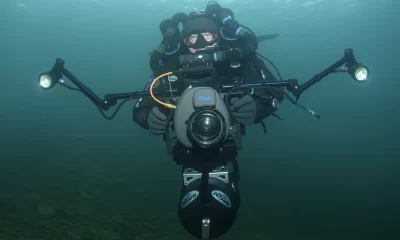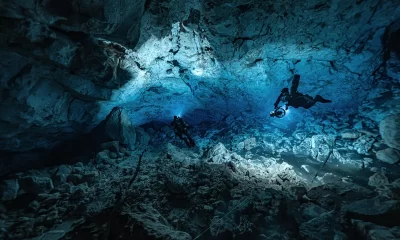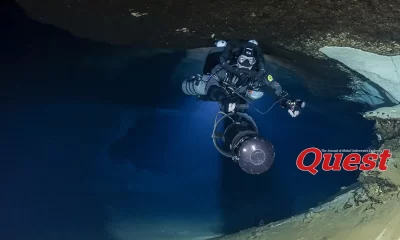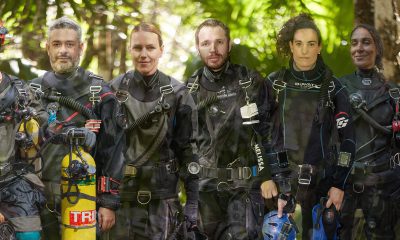Community
The Who’s Who of Sidemount

Skanda Coffield
Skanda is part of the next generation of cave instructors and explorers. Having developed his skills under Patrick Widmann and Kim Davidsson at Protec Dive Centers in Mexico, he is one of the most active explorers in the region. He has been regularly working with Phillip Lehman on exploration projects and the video and social media promotion for conservation projects such as Somos Los Cenotes.
What is sidemount to you?
As a cave instructor and explorer, sidemount is both a comfortable way to dive and a configuration that allows me to pursue cave exploration. I really enjoy the freedom of movement in the water that sidemount gives me, especially being able to look around freely in the caves. I definitely feel a week of diving or teaching in doubles takes it’s toll on my back, whereas sidemount – taking tanks one by one to the water – doesn’t have the same impact on my body. As I want to keep cave diving as long as possible, this is pretty important to me! Often, some of the caves I explore do not even have the space to get to the water in a set of doubles, so sidemount becomes the only way.
What can be improved with sidemount in general?
As I see it, sidemount diving suffers from gear manufacturers creating harnesses with little or no idea of how a sidemount harness should dive and training agencies allowing very substandard courses. Many sidemount harnesses were designed by divers (mainly cave explorers)—think of the DiveRite Nomad, Razor, XDeep Stealth. They all incorporate the design elements and experience of the people who designed them. Other manufacturers may not have the same experience to draw on, creating harnesses that may work in theory, but in suboptimal ways with unnecessary design features in the environment they are used.
Also, the requirements to become a sidemount instructor with many recreational training agencies are embarrassingly low. Many don’t even require specialised training, but simply experience (4 dives) in sidemount and then the instructor can apply for an instructor rating. With the bar set that low, students taking training from these instructors are bound to have a much lower skill level, understanding of how their harness works, and how tanks should sit and feel, as well as generally sidemount diving skills.

Was there an epiphany moment for you with sidemount?
I completed my full cave training in backmount, with the intention of learning sidemount to dive some sidemount-only caves. I remember diving at Cenote Carwash, close to Tulum, during my sidemount course. I had been many times in doubles, but being in sidemount allowed me to pass into sections of the cave I had never been able to go into before. To be able to pass restrictions that had previously prevented progress into the cave, and to see the amazing section after those restrictions was really cool! And in general, the freedom of movement in the water was a complete revelation!
Is sidemount a “fashion” trend?
Sidemount, while growing in popularity, is definitely not a new fashion in diving. Sure, many people are adopting sidemount configurations for diving in greater numbers now than in the past (not just for cave diving). But I don’t see many people going back to back mount once they have been diving sidemount! It’s definitely a configuration that many divers choose for a diverse array of reasons.
Do new students care for the history of sidemount? Or it is a tool only?
I do think that people new to sidemount are interested in its history. In all of my sidemount classes we cover the development of sidemount and its evolution. I think some of the developments surprise students! Especially when they realize that they are in the dive center where one of the most popular sidemount harnesses was created! As a big history and diving nerd I find it fascinating to learn about where and when many of our procedures, protocols and equipment were developed.
Sidemount and multistage cave diving? What’s your take?
I find that diving with three tanks (or four with a deco tank) sidemount is very comfortable. However, multistage diving, with four to five tanks in sidemount is just not comfortable for me. While I have done dives with that many tanks in sidemount, my chest is now too cluttered and access to my drysuit inlet valve is obstructed. It can be done, but swimming with four tanks on, often the gas that the fourth give me doesn’t get me much further due to the additional drag and effort to move through the water. But since getting a Kiss Sidewinder rebreather I haven’t needed to do dives with more than three tanks. So while it is possible, often the comfort of sidemount is lost when doing dives with more than three tanks.
Return to: The Who’s Who of Sidemount
DIVE DEEPER
Speaking Sidemount: E066 – Skanda Coffield and E067 – Skanda 2 – KISS Sidewinder Exploration
InDEPTH: Keep It Simple Sidewinder By Jake Bulman and Skanda Coffield

















































